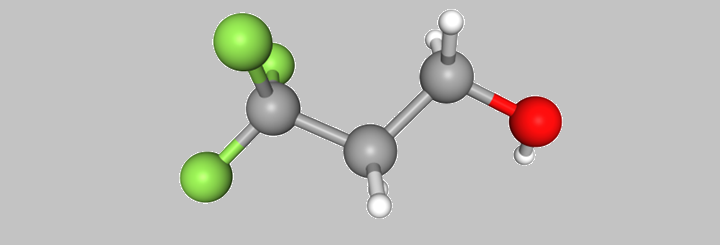INTRODUCTION
3,3,3-Trifluoropropanol is a colorless liquid that is consumed in manufacture of value-added intermediates. This apart, the halogenated alcohol is also cited to have applications in other industry verticals. It also finds uses in proteomic research and in agrochemicals.
Manufacture
It is produced by dehydrobromination of 2-bromo-3,3,3-trifluoro-1-propanol.
| Synonyms | 2-(Trifluoromethyl)ethan-1-ol 3,3,3-Trifluororopropan-1-ol 3,3,3-Trifluoropropyl alcohol |
| CAS no. | 2240-88-2 |
| EINECS no. | 613-817-8 |
| Molecular formula | C3H5F3O |
| Molecular weight | 114.07 |
| Structure |  |
Applications in Intermediates
| The trifluoro-substituted propanol is a KRM in manufacture of intermediates such as: |
|---|
| 3,3,3-Trifluoropropene oxide |
| 3,3,3-Trifluoropropanal |
| 3,3,3-Trifluoro-DL-alanine |
| 3,3,3-Trifluoropropyl acetate |
| 3,3,3-Trifluoropropyl bromide |
| (R)-(+)-alpha-Methoxy-alpha-(trifluoromethyl)-phenylacetic acid |
| 3,3,3-Trifluoropropionic acid |
Other Applications
| Trifluoropropanol is also cited to be consumed in non-synthetic applications: |
|---|
| In fire-fighting foam agents |
| In surfactants for oil extraction and gas drilling |
| In adhesives and sealants |
| In food and medicine |
SPECIFICATIONS
| Test | Unit | Specification |
|---|---|---|
| Appearance | – | Colorless liquid |
| Purity by GC | % | Min 98.0 |
STORAGE
The product is stored at ambient temperature.
PACKING
25 kg drum.
REACH Status
Not registered yet.
ExSyn offers 3,3,3-trifluoropropanol on commercial scales and welcomes enquiries. No matter the quantity you need, our exceptional quality and service will make ExSyn your supplier of choice! If you need any additional information or SDS, please contact us.
Glyceryl Stearate Citrate (GSC) is a plant-derived, biodegradable emulsifier commonly used in cosmetics and personal-care products. It functions primarily as an anionic oil-in-water (O/W) emulsifier, helping blend oils and water into smooth, stable creams and lotions. Its natural origin and gentle profile make it popular in eco-certified, organic, and sensitive-skin formulations.
DL-Serine is a racemic mixture of both the D- and L-forms of the amino acid serine, which is a polar, nonessential amino acid. It is an α-amino acid characterized by its hydroxyl-containing side chain, which enables it to take part in numerous biochemical reactions and synthetic processes. It functions as a pivotal intermediate in the biosynthesis of amino acids, including glycine and cysteine, underscoring its essential role in cellular metabolism. Moreover, it constitutes a critical pharmaceutical intermediate for the synthesis of a broad spectrum of therapeutic agents and drug candidates.
Ethyl vinyl ether is a reactive, flammable, volatile liquid with a strong ether-like odor. Featuring two conjugated functional groups—an ether and an alkene—this molecule act as important building block, especially in polymer synthesis. Its applications span multiple industrial sectors, including semiconductors, coatings, inks, fragrances, adhesives, paints, oil viscosity modifiers and pharmaceuticals, with promising potential as a dietary supplement.
Peppermint (Mentha piperita) is a common herb, also known as a hybrid mint. Its main components are oxygenated monoterpenes: alcohols, esters and ketones. Peppermint oleoresin microencapsulated powder is a white to off-white coloured powder produced from the seeds of the plant. In order to protect and maintain the stability of peppermint oil, microencapsulation is carried out through process optimization using the coacervation technique. This technique helps limit the loss and degradation of flavours and aromas during processing and storage. It offers versatile applications across multiple industries — from food and beverages to pharmaceuticals, cosmetics, and textiles.
5-Methyl-3-vinyl-2-oxazolidinone (V-MOX) is a highly reactive monomer valued for its low viscosity, mild odor, and excellent reactivity. It is widely used as a reactive diluent in UV-curable inks and coatings, where it enhances adhesion, produces brighter colors, and improves safety compared to conventional diluents. In addition, V-MOX serves as a key building block in the synthesis of kinetic hydrate inhibitor (KHI) polymers, which are applied in oil and gas production to prevent hydrate blockages in pipelines.
Zinc ricinoleate is the zinc salt of ricinoleic acid, a hydroxylated fatty acid derived mainly from castor oil (Ricinus communis). It appears as a white to slightly yellowish powder, waxy solid, or paste, depending on formulation. Its most valuable property is its ability to trap and absorb odor molecules such as amines, sulfides, and short-chain fatty acids, making it an essential ingredient in deodorant and odor-control products.
2-(tert-Butyl amino)ethyl methacrylate (TBAEMA) is a functional methacrylate monomer that contains a secondary amine group and a hydrophobic tert-butyl moiety, giving it excellent versatility in pH-responsive and adhesion-enhancing polymer systems.
It is valued in printing ink formulations for its ability to enhance adhesion, flexibility, and surface interaction.
Commonly known as potassium bis(fluorosulfonyl)imide (KFSI), the compound has a three-carbon backbone bearing six fluorine atoms and two sulfonimide (-SO₂F) groups. The molecule’s architecture lends it both high chemical stability and useful reactivity. Because of its excellent ionic conductivity and thermal / electrochemical stability, it finds use in advanced electrolyte formulations—for example in lithium-ion and next-generation batteries, in ionic liquids, and in other electrochemical systems.
Colchicine is a naturally occurring alkaloid obtained primarily from the autumn crocus (Colchicum autumnale) and related species. It has been used in medicine for centuries, especially for the treatment of gout and Familial Mediterranean Fever. In modern medicine, Colchicine is valued also in conditions like pericarditis, Behçet’s disease, and certain dermatological and cardiac disorders.
